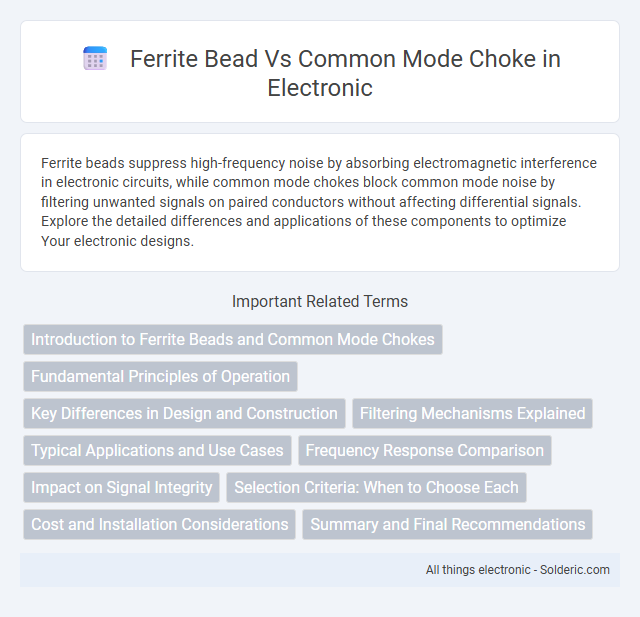Ferrite beads suppress high-frequency noise by absorbing electromagnetic interference in electronic circuits, while common mode chokes block common mode noise by filtering unwanted signals on paired conductors without affecting differential signals. Explore the detailed differences and applications of these components to optimize Your electronic designs.
Comparison Table
| Feature | Ferrite Bead | Common Mode Choke |
|---|---|---|
| Function | Suppresses high-frequency noise on single conductor | Reduces common mode noise on paired conductors |
| Construction | Single ferrite core around conductor | Two or more windings on a ferrite core |
| Noise Filtering Type | Differential mode noise | Common mode noise |
| Frequency Range | High-frequency (MHz range) | Low to mid-frequency (kHz to MHz) |
| Typical Applications | Power lines, signal cables | Data lines, power supplies with noise on both lines |
| Insertion Loss | Low | Moderate |
| Physical Size | Compact | Larger due to multiple windings |
Introduction to Ferrite Beads and Common Mode Chokes
Ferrite beads and common mode chokes are essential components used to suppress electromagnetic interference (EMI) in electronic circuits. Ferrite beads act as high-frequency noise filters by dissipating unwanted signals as heat, while common mode chokes block noise currents common to both lines, improving signal integrity in data and power transmission. Your choice between these components depends on the specific interference type and frequency range present in your application.
Fundamental Principles of Operation
Ferrite beads function by dissipating high-frequency noise energy as heat through their resistive properties, effectively filtering electromagnetic interference (EMI) in signal lines. Common mode chokes operate by presenting high impedance to common mode noise currents using inductive coupling across multiple windings, thus preventing EMI from propagating through power or signal cables. Both components serve as EMI suppression devices, but ferrite beads target higher frequency noise damping, while common mode chokes focus on balancing and attenuating common mode signals.
Key Differences in Design and Construction
Ferrite beads consist of a single ferrite core designed to suppress high-frequency noise by absorbing electromagnetic interference, whereas common mode chokes use two or more windings on a shared magnetic core to block common-mode noise while allowing differential signals to pass. The ferrite bead's simple, unidirectional structure targets specific noise frequencies, making it ideal for high-frequency suppression in compact circuits. Common mode chokes feature symmetrical windings that enhance noise rejection in balanced lines, offering superior performance in differential signal environments compared to ferrite beads.
Filtering Mechanisms Explained
Ferrite beads suppress high-frequency noise by dissipating electromagnetic interference (EMI) as heat through their resistive properties, effectively filtering out unwanted signals in your circuits. Common mode chokes filter noise by blocking common mode currents using inductance, allowing differential signals to pass while reducing interference on power and signal lines. Understanding these distinct filtering mechanisms helps optimize noise reduction for electronic devices and ensure signal integrity.
Typical Applications and Use Cases
Ferrite beads are commonly used in high-frequency noise suppression applications such as power supply lines, signal lines, and EMI filtering in consumer electronics and communication devices. Common mode chokes are typically employed in differential data lines, power input filters, and Ethernet or USB interfaces to reduce common mode interference and improve electromagnetic compatibility. Both components play crucial roles in maintaining signal integrity and minimizing electromagnetic interference in electronic circuits.
Frequency Response Comparison
Ferrite beads offer superior high-frequency attenuation, typically effective from several MHz up to GHz ranges, making them ideal for suppressing high-frequency noise in electronic circuits. Common mode chokes excel at attenuating low to mid-frequency noise, often in the kHz to low MHz range, by targeting differential signals and common mode interference on power lines. Frequency response differences dictate their application: ferrite beads are preferred for high-frequency noise filtering, while common mode chokes are better suited for low-frequency noise reduction and improving electromagnetic compatibility.
Impact on Signal Integrity
Ferrite beads and common mode chokes both play crucial roles in maintaining signal integrity by suppressing electromagnetic interference (EMI). Ferrite beads primarily filter high-frequency noise by acting as a low-pass filter, limiting high-frequency signals and preventing signal distortion in sensitive circuits. Common mode chokes reduce noise caused by common mode currents on differential signal lines, improving your system's overall signal integrity by maintaining cleaner signals and reducing data errors.
Selection Criteria: When to Choose Each
Ferrite beads are ideal for suppressing high-frequency noise on single conductors, making them suitable for filtering signals or power lines where minimal insertion loss is required. Common mode chokes excel at reducing common mode noise on differential pairs or multi-conductor cables by blocking interference while allowing normal differential signals to pass through. Your selection depends on the type of noise, frequency range, and application requirements, with ferrite beads preferred for targeted high-frequency noise suppression and common mode chokes for comprehensive noise filtering on balanced lines.
Cost and Installation Considerations
Ferrite beads generally offer a lower cost and simpler installation process compared to common mode chokes, making them ideal for budget-sensitive projects and quick integration. Common mode chokes, while more expensive, provide superior noise suppression in complex circuits, often requiring careful placement and additional mounting space. Your choice depends on balancing budget constraints with the desired electromagnetic interference performance and available PCB real estate.
Summary and Final Recommendations
Ferrite beads and common mode chokes both suppress electromagnetic interference but differ in application; ferrite beads excel at high-frequency noise attenuation in single-ended lines, while common mode chokes target noise on differential or balanced lines by blocking common mode currents. For PCB designers aiming to reduce EMI in power lines or signal traces, ferrite beads provide a compact, cost-effective solution, especially for high-frequency noise, whereas common mode chokes are recommended for differential signal pairs with common mode noise issues. Selecting between these components depends on the circuit topology and noise characteristics, with a combination of both often providing optimal noise suppression in complex EMI environments.
Ferrite bead vs Common mode choke Infographic

 solderic.com
solderic.com